Analysis of International Financial Reporting for Able Plc (2017)
VerifiedAdded on 2020/06/04
|13
|4055
|42
Report
AI Summary
This report examines the application of International Financial Reporting Standards (IFRS) to the financial statements of Able Plc for the year 2017. It begins with an introduction to IFRS and its role in preparing financial statements, emphasizing its importance for stakeholders. The report then presents and analyzes Able Plc's income statement, calculating net income and discussing key components like revenue, cost of sales, and operating expenses. It highlights the critical aspects of regulatory discussions and relevant accounting standards. Furthermore, the report delves into identifying and valuing intangible assets, specifically focusing on the capitalization of research and development (R&D) costs according to IAS 38. Finally, it explains the valuation of inventories at the lower of cost and net realizable value. The report concludes by summarizing the key findings and implications of IFRS on Able Plc's financial reporting and performance.
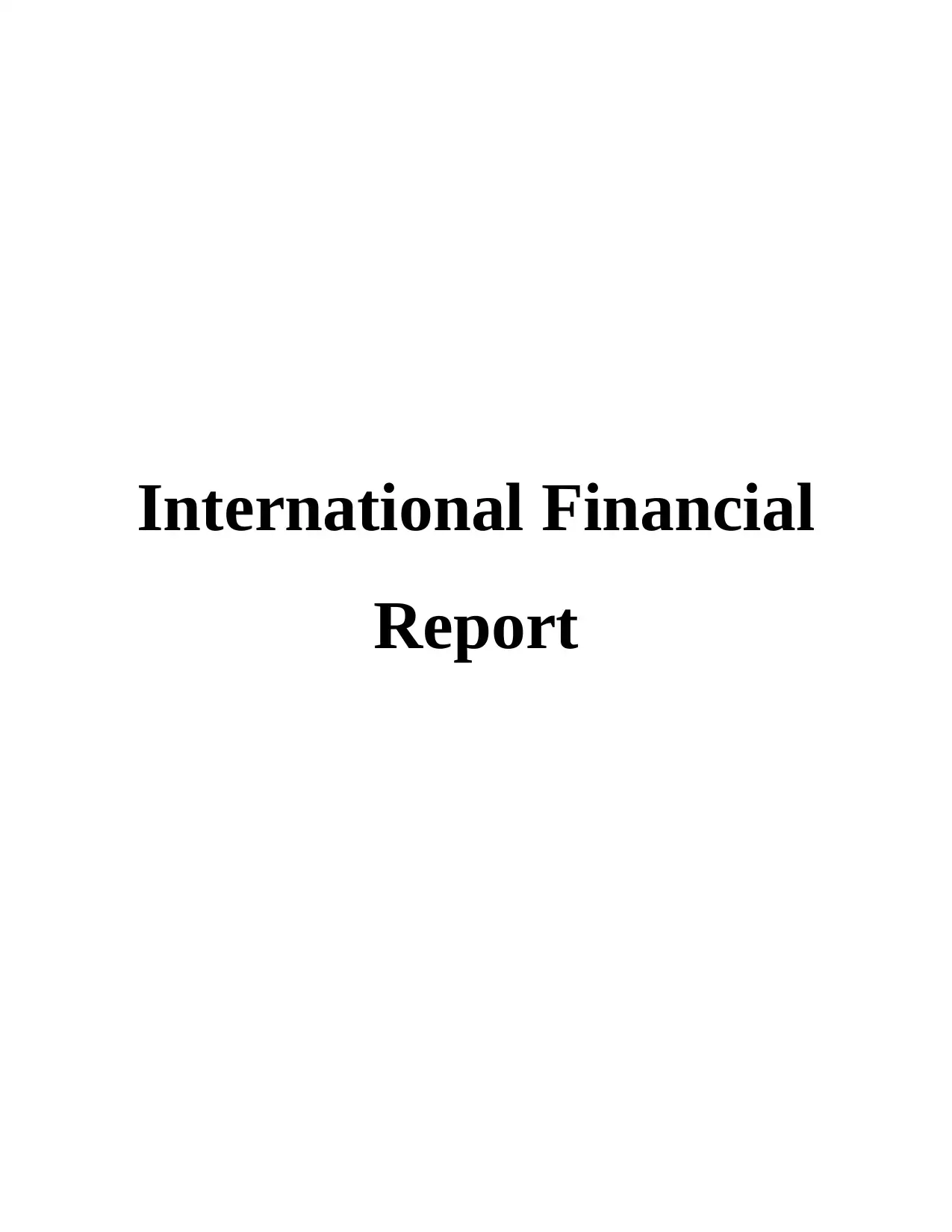
International Financial
Report
Report
Paraphrase This Document
Need a fresh take? Get an instant paraphrase of this document with our AI Paraphraser
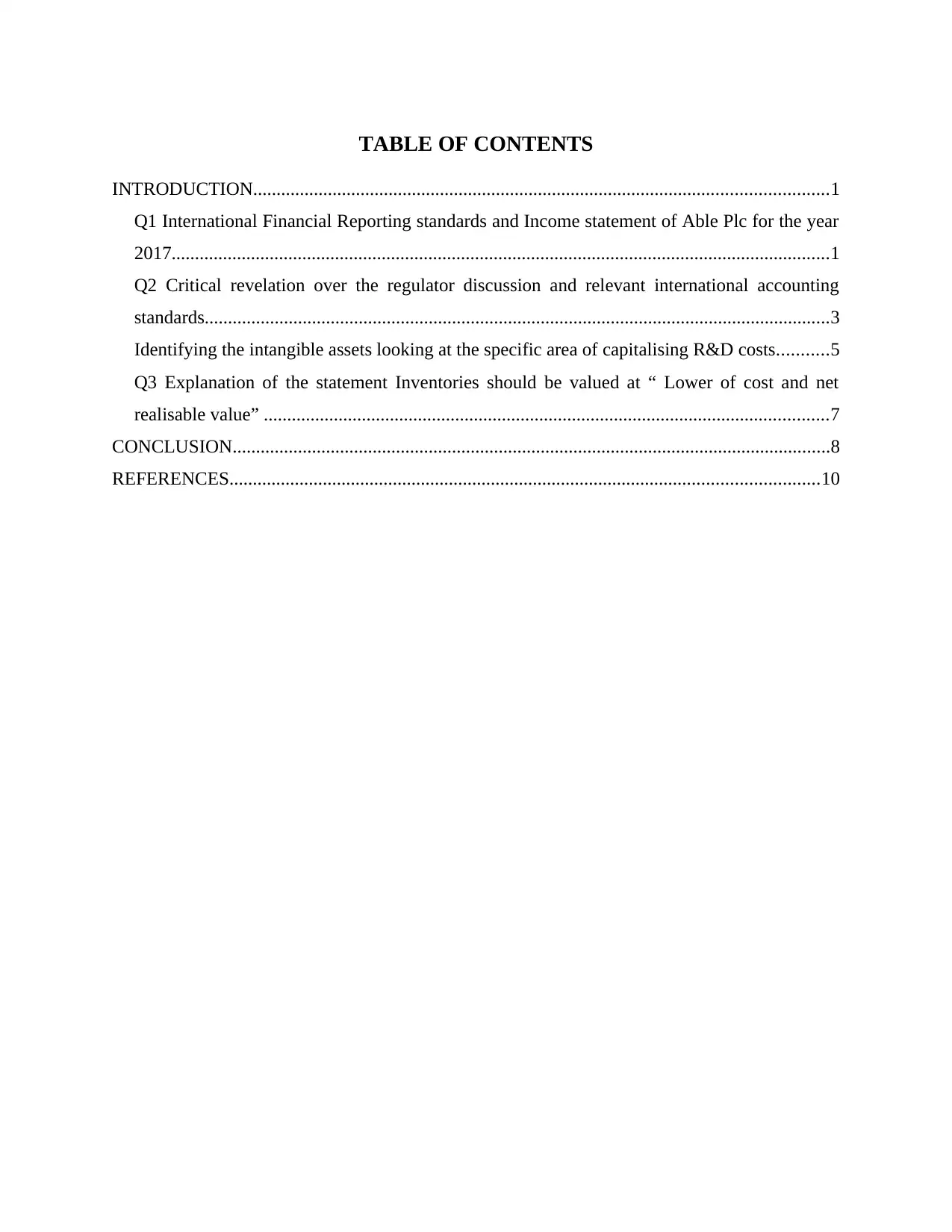
TABLE OF CONTENTS
INTRODUCTION...........................................................................................................................1
Q1 International Financial Reporting standards and Income statement of Able Plc for the year
2017.............................................................................................................................................1
Q2 Critical revelation over the regulator discussion and relevant international accounting
standards......................................................................................................................................3
Identifying the intangible assets looking at the specific area of capitalising R&D costs...........5
Q3 Explanation of the statement Inventories should be valued at “ Lower of cost and net
realisable value” .........................................................................................................................7
CONCLUSION................................................................................................................................8
REFERENCES..............................................................................................................................10
INTRODUCTION...........................................................................................................................1
Q1 International Financial Reporting standards and Income statement of Able Plc for the year
2017.............................................................................................................................................1
Q2 Critical revelation over the regulator discussion and relevant international accounting
standards......................................................................................................................................3
Identifying the intangible assets looking at the specific area of capitalising R&D costs...........5
Q3 Explanation of the statement Inventories should be valued at “ Lower of cost and net
realisable value” .........................................................................................................................7
CONCLUSION................................................................................................................................8
REFERENCES..............................................................................................................................10
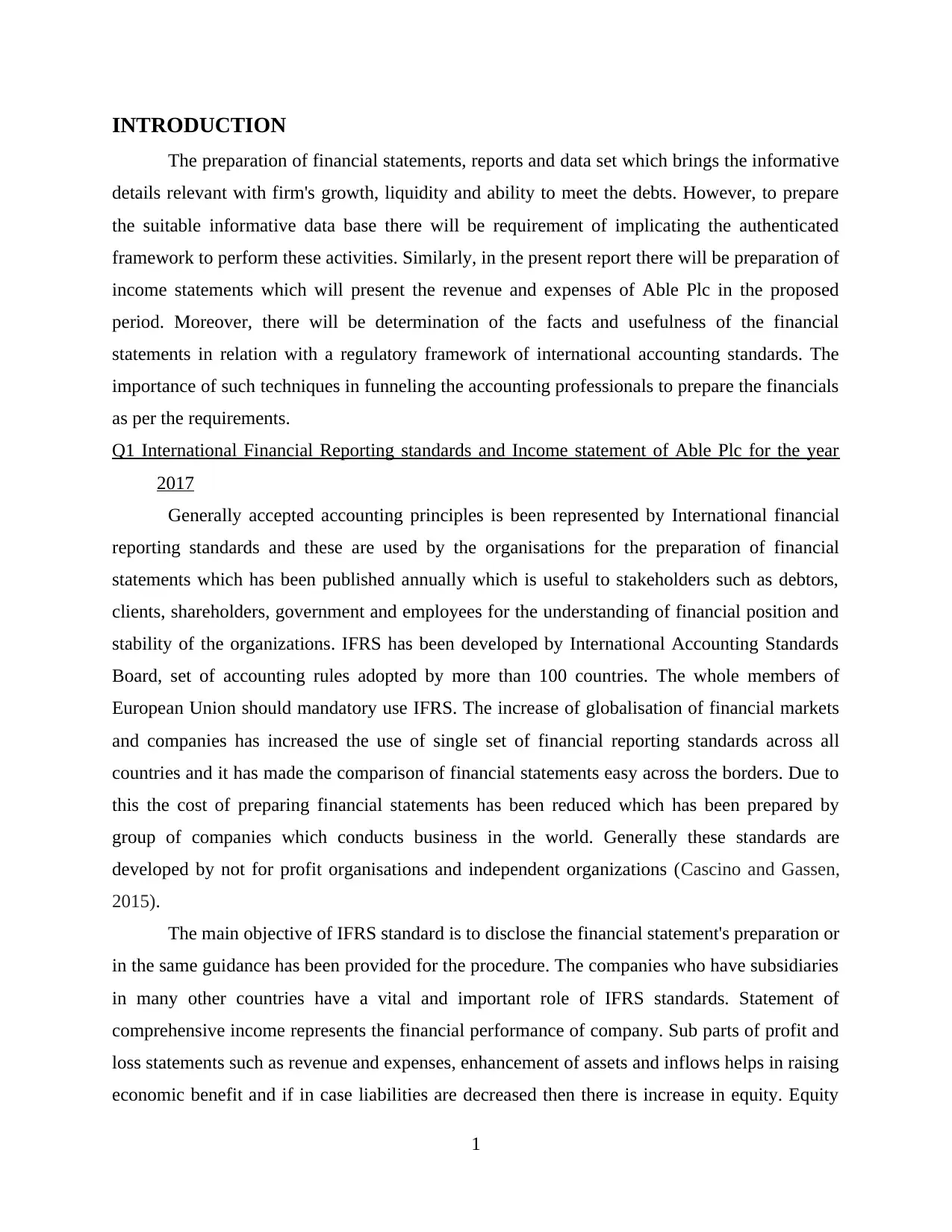
INTRODUCTION
The preparation of financial statements, reports and data set which brings the informative
details relevant with firm's growth, liquidity and ability to meet the debts. However, to prepare
the suitable informative data base there will be requirement of implicating the authenticated
framework to perform these activities. Similarly, in the present report there will be preparation of
income statements which will present the revenue and expenses of Able Plc in the proposed
period. Moreover, there will be determination of the facts and usefulness of the financial
statements in relation with a regulatory framework of international accounting standards. The
importance of such techniques in funneling the accounting professionals to prepare the financials
as per the requirements.
Q1 International Financial Reporting standards and Income statement of Able Plc for the year
2017
Generally accepted accounting principles is been represented by International financial
reporting standards and these are used by the organisations for the preparation of financial
statements which has been published annually which is useful to stakeholders such as debtors,
clients, shareholders, government and employees for the understanding of financial position and
stability of the organizations. IFRS has been developed by International Accounting Standards
Board, set of accounting rules adopted by more than 100 countries. The whole members of
European Union should mandatory use IFRS. The increase of globalisation of financial markets
and companies has increased the use of single set of financial reporting standards across all
countries and it has made the comparison of financial statements easy across the borders. Due to
this the cost of preparing financial statements has been reduced which has been prepared by
group of companies which conducts business in the world. Generally these standards are
developed by not for profit organisations and independent organizations (Cascino and Gassen,
2015).
The main objective of IFRS standard is to disclose the financial statement's preparation or
in the same guidance has been provided for the procedure. The companies who have subsidiaries
in many other countries have a vital and important role of IFRS standards. Statement of
comprehensive income represents the financial performance of company. Sub parts of profit and
loss statements such as revenue and expenses, enhancement of assets and inflows helps in raising
economic benefit and if in case liabilities are decreased then there is increase in equity. Equity
1
The preparation of financial statements, reports and data set which brings the informative
details relevant with firm's growth, liquidity and ability to meet the debts. However, to prepare
the suitable informative data base there will be requirement of implicating the authenticated
framework to perform these activities. Similarly, in the present report there will be preparation of
income statements which will present the revenue and expenses of Able Plc in the proposed
period. Moreover, there will be determination of the facts and usefulness of the financial
statements in relation with a regulatory framework of international accounting standards. The
importance of such techniques in funneling the accounting professionals to prepare the financials
as per the requirements.
Q1 International Financial Reporting standards and Income statement of Able Plc for the year
2017
Generally accepted accounting principles is been represented by International financial
reporting standards and these are used by the organisations for the preparation of financial
statements which has been published annually which is useful to stakeholders such as debtors,
clients, shareholders, government and employees for the understanding of financial position and
stability of the organizations. IFRS has been developed by International Accounting Standards
Board, set of accounting rules adopted by more than 100 countries. The whole members of
European Union should mandatory use IFRS. The increase of globalisation of financial markets
and companies has increased the use of single set of financial reporting standards across all
countries and it has made the comparison of financial statements easy across the borders. Due to
this the cost of preparing financial statements has been reduced which has been prepared by
group of companies which conducts business in the world. Generally these standards are
developed by not for profit organisations and independent organizations (Cascino and Gassen,
2015).
The main objective of IFRS standard is to disclose the financial statement's preparation or
in the same guidance has been provided for the procedure. The companies who have subsidiaries
in many other countries have a vital and important role of IFRS standards. Statement of
comprehensive income represents the financial performance of company. Sub parts of profit and
loss statements such as revenue and expenses, enhancement of assets and inflows helps in raising
economic benefit and if in case liabilities are decreased then there is increase in equity. Equity
1
⊘ This is a preview!⊘
Do you want full access?
Subscribe today to unlock all pages.

Trusted by 1+ million students worldwide
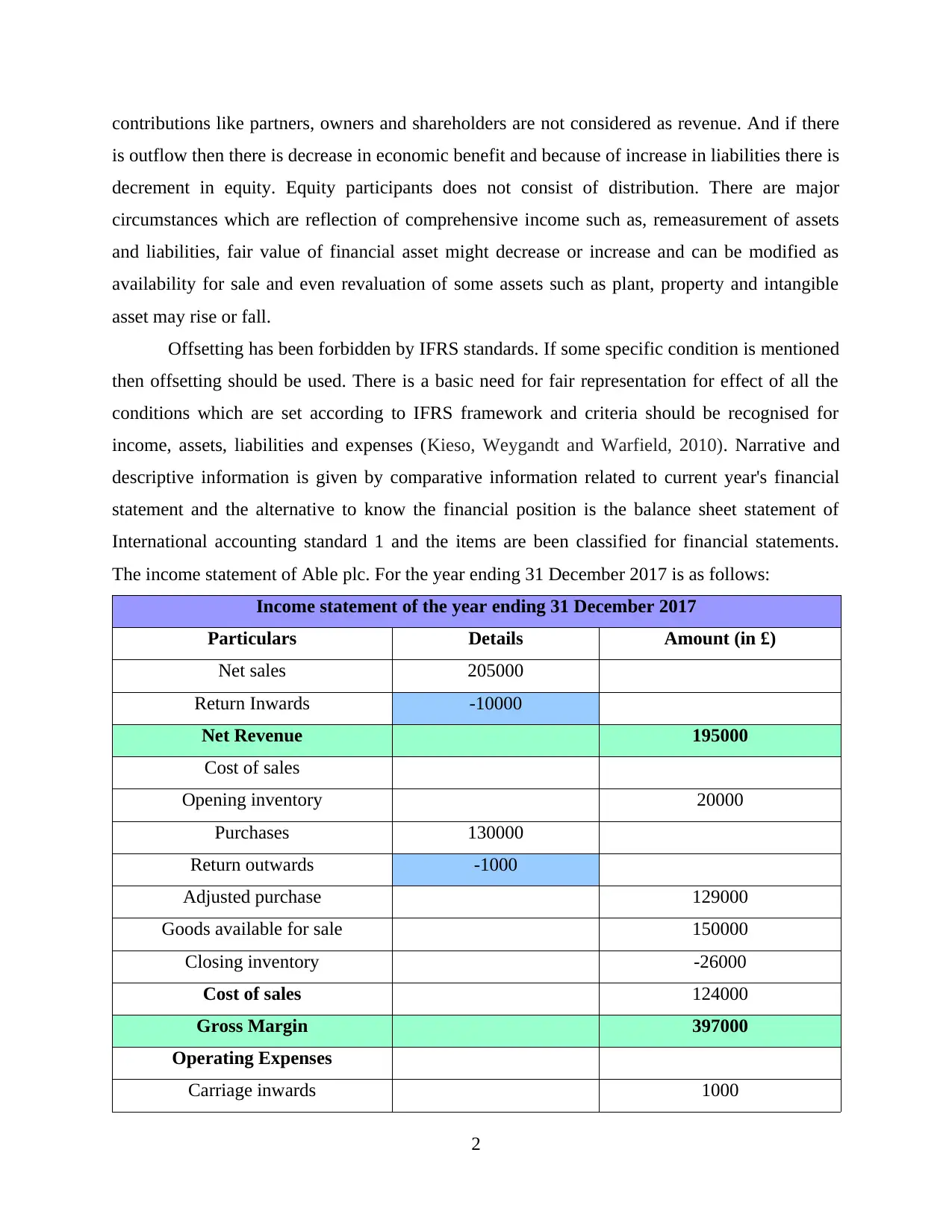
contributions like partners, owners and shareholders are not considered as revenue. And if there
is outflow then there is decrease in economic benefit and because of increase in liabilities there is
decrement in equity. Equity participants does not consist of distribution. There are major
circumstances which are reflection of comprehensive income such as, remeasurement of assets
and liabilities, fair value of financial asset might decrease or increase and can be modified as
availability for sale and even revaluation of some assets such as plant, property and intangible
asset may rise or fall.
Offsetting has been forbidden by IFRS standards. If some specific condition is mentioned
then offsetting should be used. There is a basic need for fair representation for effect of all the
conditions which are set according to IFRS framework and criteria should be recognised for
income, assets, liabilities and expenses (Kieso, Weygandt and Warfield, 2010). Narrative and
descriptive information is given by comparative information related to current year's financial
statement and the alternative to know the financial position is the balance sheet statement of
International accounting standard 1 and the items are been classified for financial statements.
The income statement of Able plc. For the year ending 31 December 2017 is as follows:
Income statement of the year ending 31 December 2017
Particulars Details Amount (in £)
Net sales 205000
Return Inwards -10000
Net Revenue 195000
Cost of sales
Opening inventory 20000
Purchases 130000
Return outwards -1000
Adjusted purchase 129000
Goods available for sale 150000
Closing inventory -26000
Cost of sales 124000
Gross Margin 397000
Operating Expenses
Carriage inwards 1000
2
is outflow then there is decrease in economic benefit and because of increase in liabilities there is
decrement in equity. Equity participants does not consist of distribution. There are major
circumstances which are reflection of comprehensive income such as, remeasurement of assets
and liabilities, fair value of financial asset might decrease or increase and can be modified as
availability for sale and even revaluation of some assets such as plant, property and intangible
asset may rise or fall.
Offsetting has been forbidden by IFRS standards. If some specific condition is mentioned
then offsetting should be used. There is a basic need for fair representation for effect of all the
conditions which are set according to IFRS framework and criteria should be recognised for
income, assets, liabilities and expenses (Kieso, Weygandt and Warfield, 2010). Narrative and
descriptive information is given by comparative information related to current year's financial
statement and the alternative to know the financial position is the balance sheet statement of
International accounting standard 1 and the items are been classified for financial statements.
The income statement of Able plc. For the year ending 31 December 2017 is as follows:
Income statement of the year ending 31 December 2017
Particulars Details Amount (in £)
Net sales 205000
Return Inwards -10000
Net Revenue 195000
Cost of sales
Opening inventory 20000
Purchases 130000
Return outwards -1000
Adjusted purchase 129000
Goods available for sale 150000
Closing inventory -26000
Cost of sales 124000
Gross Margin 397000
Operating Expenses
Carriage inwards 1000
2
Paraphrase This Document
Need a fresh take? Get an instant paraphrase of this document with our AI Paraphraser
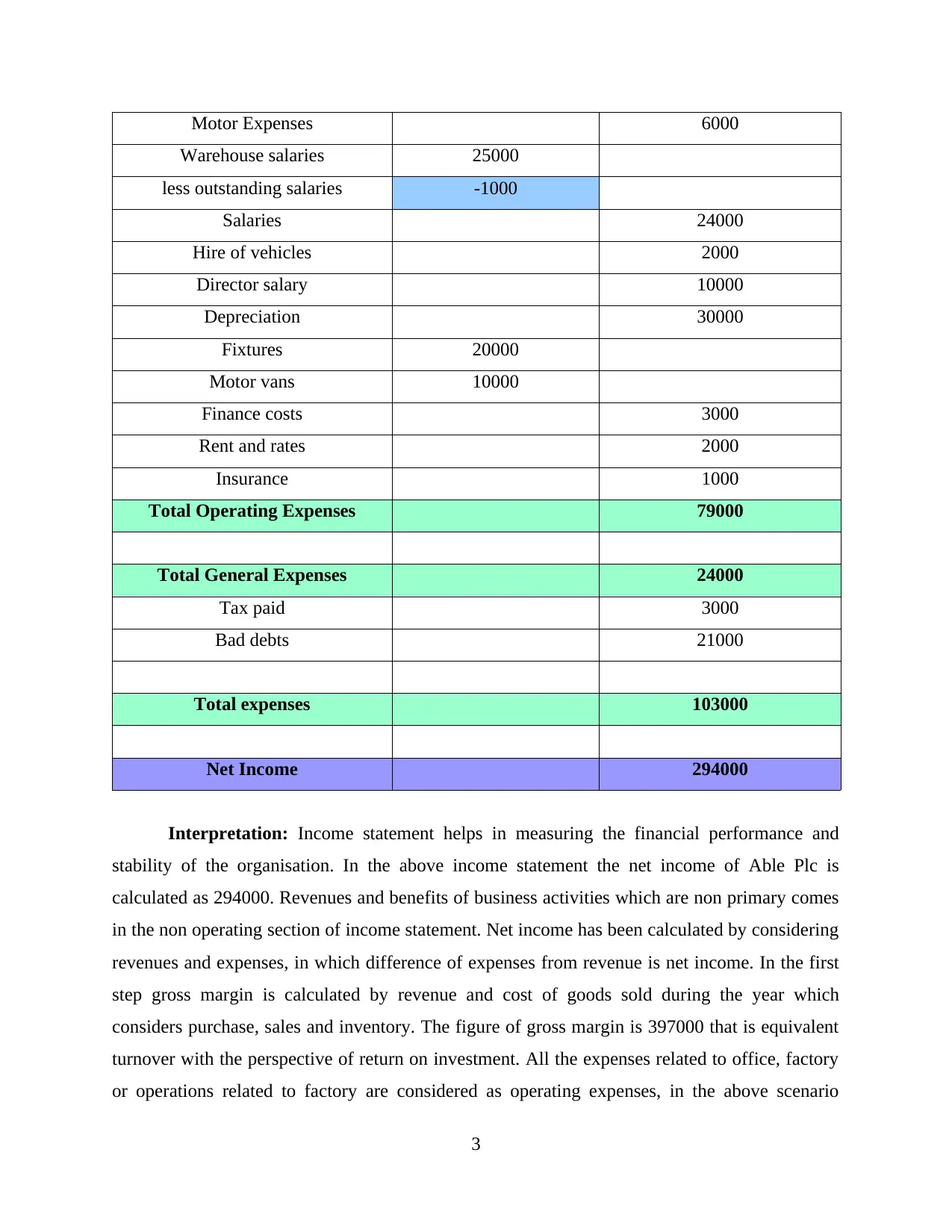
Motor Expenses 6000
Warehouse salaries 25000
less outstanding salaries -1000
Salaries 24000
Hire of vehicles 2000
Director salary 10000
Depreciation 30000
Fixtures 20000
Motor vans 10000
Finance costs 3000
Rent and rates 2000
Insurance 1000
Total Operating Expenses 79000
Total General Expenses 24000
Tax paid 3000
Bad debts 21000
Total expenses 103000
Net Income 294000
Interpretation: Income statement helps in measuring the financial performance and
stability of the organisation. In the above income statement the net income of Able Plc is
calculated as 294000. Revenues and benefits of business activities which are non primary comes
in the non operating section of income statement. Net income has been calculated by considering
revenues and expenses, in which difference of expenses from revenue is net income. In the first
step gross margin is calculated by revenue and cost of goods sold during the year which
considers purchase, sales and inventory. The figure of gross margin is 397000 that is equivalent
turnover with the perspective of return on investment. All the expenses related to office, factory
or operations related to factory are considered as operating expenses, in the above scenario
3
Warehouse salaries 25000
less outstanding salaries -1000
Salaries 24000
Hire of vehicles 2000
Director salary 10000
Depreciation 30000
Fixtures 20000
Motor vans 10000
Finance costs 3000
Rent and rates 2000
Insurance 1000
Total Operating Expenses 79000
Total General Expenses 24000
Tax paid 3000
Bad debts 21000
Total expenses 103000
Net Income 294000
Interpretation: Income statement helps in measuring the financial performance and
stability of the organisation. In the above income statement the net income of Able Plc is
calculated as 294000. Revenues and benefits of business activities which are non primary comes
in the non operating section of income statement. Net income has been calculated by considering
revenues and expenses, in which difference of expenses from revenue is net income. In the first
step gross margin is calculated by revenue and cost of goods sold during the year which
considers purchase, sales and inventory. The figure of gross margin is 397000 that is equivalent
turnover with the perspective of return on investment. All the expenses related to office, factory
or operations related to factory are considered as operating expenses, in the above scenario
3
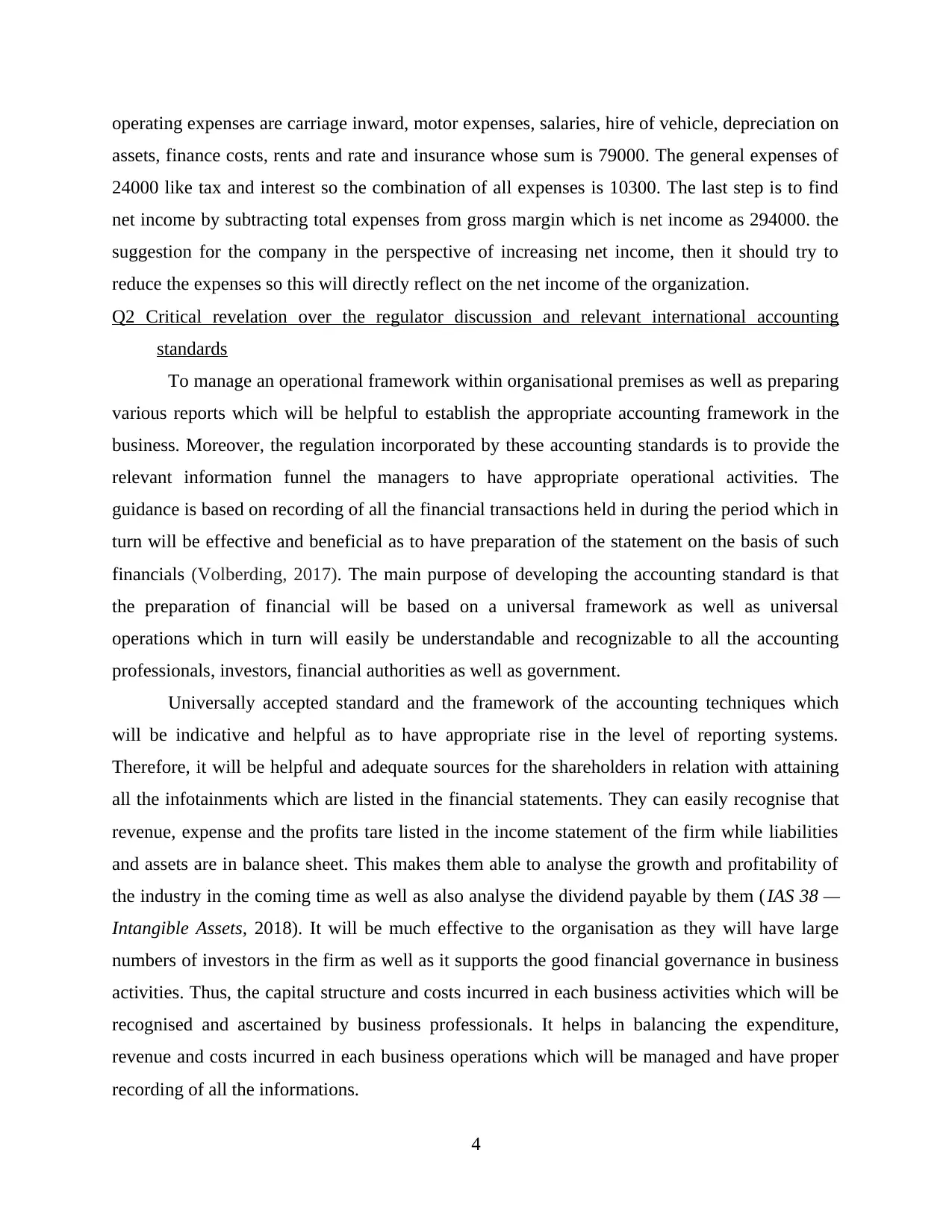
operating expenses are carriage inward, motor expenses, salaries, hire of vehicle, depreciation on
assets, finance costs, rents and rate and insurance whose sum is 79000. The general expenses of
24000 like tax and interest so the combination of all expenses is 10300. The last step is to find
net income by subtracting total expenses from gross margin which is net income as 294000. the
suggestion for the company in the perspective of increasing net income, then it should try to
reduce the expenses so this will directly reflect on the net income of the organization.
Q2 Critical revelation over the regulator discussion and relevant international accounting
standards
To manage an operational framework within organisational premises as well as preparing
various reports which will be helpful to establish the appropriate accounting framework in the
business. Moreover, the regulation incorporated by these accounting standards is to provide the
relevant information funnel the managers to have appropriate operational activities. The
guidance is based on recording of all the financial transactions held in during the period which in
turn will be effective and beneficial as to have preparation of the statement on the basis of such
financials (Volberding, 2017). The main purpose of developing the accounting standard is that
the preparation of financial will be based on a universal framework as well as universal
operations which in turn will easily be understandable and recognizable to all the accounting
professionals, investors, financial authorities as well as government.
Universally accepted standard and the framework of the accounting techniques which
will be indicative and helpful as to have appropriate rise in the level of reporting systems.
Therefore, it will be helpful and adequate sources for the shareholders in relation with attaining
all the infotainments which are listed in the financial statements. They can easily recognise that
revenue, expense and the profits tare listed in the income statement of the firm while liabilities
and assets are in balance sheet. This makes them able to analyse the growth and profitability of
the industry in the coming time as well as also analyse the dividend payable by them (IAS 38 —
Intangible Assets, 2018). It will be much effective to the organisation as they will have large
numbers of investors in the firm as well as it supports the good financial governance in business
activities. Thus, the capital structure and costs incurred in each business activities which will be
recognised and ascertained by business professionals. It helps in balancing the expenditure,
revenue and costs incurred in each business operations which will be managed and have proper
recording of all the informations.
4
assets, finance costs, rents and rate and insurance whose sum is 79000. The general expenses of
24000 like tax and interest so the combination of all expenses is 10300. The last step is to find
net income by subtracting total expenses from gross margin which is net income as 294000. the
suggestion for the company in the perspective of increasing net income, then it should try to
reduce the expenses so this will directly reflect on the net income of the organization.
Q2 Critical revelation over the regulator discussion and relevant international accounting
standards
To manage an operational framework within organisational premises as well as preparing
various reports which will be helpful to establish the appropriate accounting framework in the
business. Moreover, the regulation incorporated by these accounting standards is to provide the
relevant information funnel the managers to have appropriate operational activities. The
guidance is based on recording of all the financial transactions held in during the period which in
turn will be effective and beneficial as to have preparation of the statement on the basis of such
financials (Volberding, 2017). The main purpose of developing the accounting standard is that
the preparation of financial will be based on a universal framework as well as universal
operations which in turn will easily be understandable and recognizable to all the accounting
professionals, investors, financial authorities as well as government.
Universally accepted standard and the framework of the accounting techniques which
will be indicative and helpful as to have appropriate rise in the level of reporting systems.
Therefore, it will be helpful and adequate sources for the shareholders in relation with attaining
all the infotainments which are listed in the financial statements. They can easily recognise that
revenue, expense and the profits tare listed in the income statement of the firm while liabilities
and assets are in balance sheet. This makes them able to analyse the growth and profitability of
the industry in the coming time as well as also analyse the dividend payable by them (IAS 38 —
Intangible Assets, 2018). It will be much effective to the organisation as they will have large
numbers of investors in the firm as well as it supports the good financial governance in business
activities. Thus, the capital structure and costs incurred in each business activities which will be
recognised and ascertained by business professionals. It helps in balancing the expenditure,
revenue and costs incurred in each business operations which will be managed and have proper
recording of all the informations.
4
⊘ This is a preview!⊘
Do you want full access?
Subscribe today to unlock all pages.

Trusted by 1+ million students worldwide
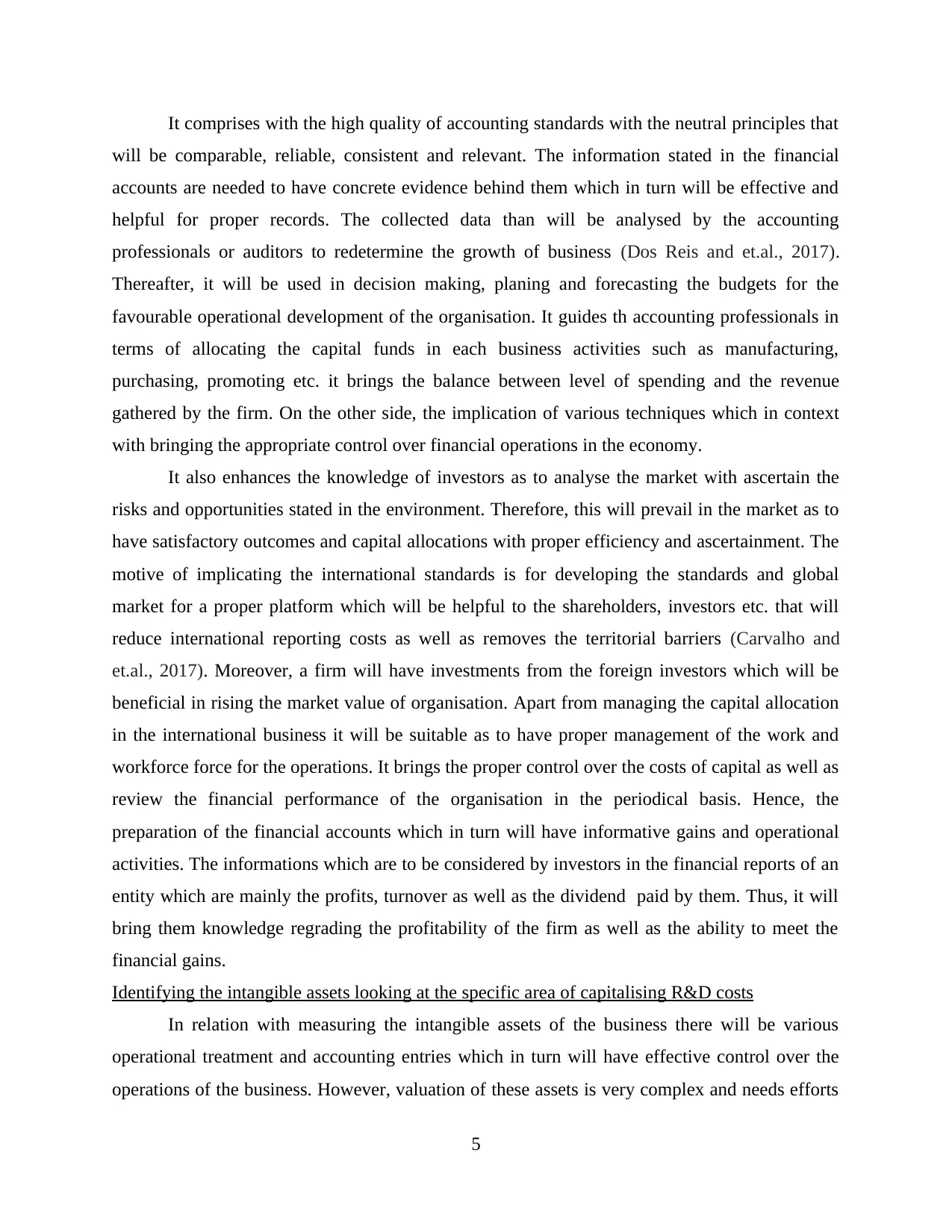
It comprises with the high quality of accounting standards with the neutral principles that
will be comparable, reliable, consistent and relevant. The information stated in the financial
accounts are needed to have concrete evidence behind them which in turn will be effective and
helpful for proper records. The collected data than will be analysed by the accounting
professionals or auditors to redetermine the growth of business (Dos Reis and et.al., 2017).
Thereafter, it will be used in decision making, planing and forecasting the budgets for the
favourable operational development of the organisation. It guides th accounting professionals in
terms of allocating the capital funds in each business activities such as manufacturing,
purchasing, promoting etc. it brings the balance between level of spending and the revenue
gathered by the firm. On the other side, the implication of various techniques which in context
with bringing the appropriate control over financial operations in the economy.
It also enhances the knowledge of investors as to analyse the market with ascertain the
risks and opportunities stated in the environment. Therefore, this will prevail in the market as to
have satisfactory outcomes and capital allocations with proper efficiency and ascertainment. The
motive of implicating the international standards is for developing the standards and global
market for a proper platform which will be helpful to the shareholders, investors etc. that will
reduce international reporting costs as well as removes the territorial barriers (Carvalho and
et.al., 2017). Moreover, a firm will have investments from the foreign investors which will be
beneficial in rising the market value of organisation. Apart from managing the capital allocation
in the international business it will be suitable as to have proper management of the work and
workforce force for the operations. It brings the proper control over the costs of capital as well as
review the financial performance of the organisation in the periodical basis. Hence, the
preparation of the financial accounts which in turn will have informative gains and operational
activities. The informations which are to be considered by investors in the financial reports of an
entity which are mainly the profits, turnover as well as the dividend paid by them. Thus, it will
bring them knowledge regrading the profitability of the firm as well as the ability to meet the
financial gains.
Identifying the intangible assets looking at the specific area of capitalising R&D costs
In relation with measuring the intangible assets of the business there will be various
operational treatment and accounting entries which in turn will have effective control over the
operations of the business. However, valuation of these assets is very complex and needs efforts
5
will be comparable, reliable, consistent and relevant. The information stated in the financial
accounts are needed to have concrete evidence behind them which in turn will be effective and
helpful for proper records. The collected data than will be analysed by the accounting
professionals or auditors to redetermine the growth of business (Dos Reis and et.al., 2017).
Thereafter, it will be used in decision making, planing and forecasting the budgets for the
favourable operational development of the organisation. It guides th accounting professionals in
terms of allocating the capital funds in each business activities such as manufacturing,
purchasing, promoting etc. it brings the balance between level of spending and the revenue
gathered by the firm. On the other side, the implication of various techniques which in context
with bringing the appropriate control over financial operations in the economy.
It also enhances the knowledge of investors as to analyse the market with ascertain the
risks and opportunities stated in the environment. Therefore, this will prevail in the market as to
have satisfactory outcomes and capital allocations with proper efficiency and ascertainment. The
motive of implicating the international standards is for developing the standards and global
market for a proper platform which will be helpful to the shareholders, investors etc. that will
reduce international reporting costs as well as removes the territorial barriers (Carvalho and
et.al., 2017). Moreover, a firm will have investments from the foreign investors which will be
beneficial in rising the market value of organisation. Apart from managing the capital allocation
in the international business it will be suitable as to have proper management of the work and
workforce force for the operations. It brings the proper control over the costs of capital as well as
review the financial performance of the organisation in the periodical basis. Hence, the
preparation of the financial accounts which in turn will have informative gains and operational
activities. The informations which are to be considered by investors in the financial reports of an
entity which are mainly the profits, turnover as well as the dividend paid by them. Thus, it will
bring them knowledge regrading the profitability of the firm as well as the ability to meet the
financial gains.
Identifying the intangible assets looking at the specific area of capitalising R&D costs
In relation with measuring the intangible assets of the business there will be various
operational treatment and accounting entries which in turn will have effective control over the
operations of the business. However, valuation of these assets is very complex and needs efforts
5
Paraphrase This Document
Need a fresh take? Get an instant paraphrase of this document with our AI Paraphraser
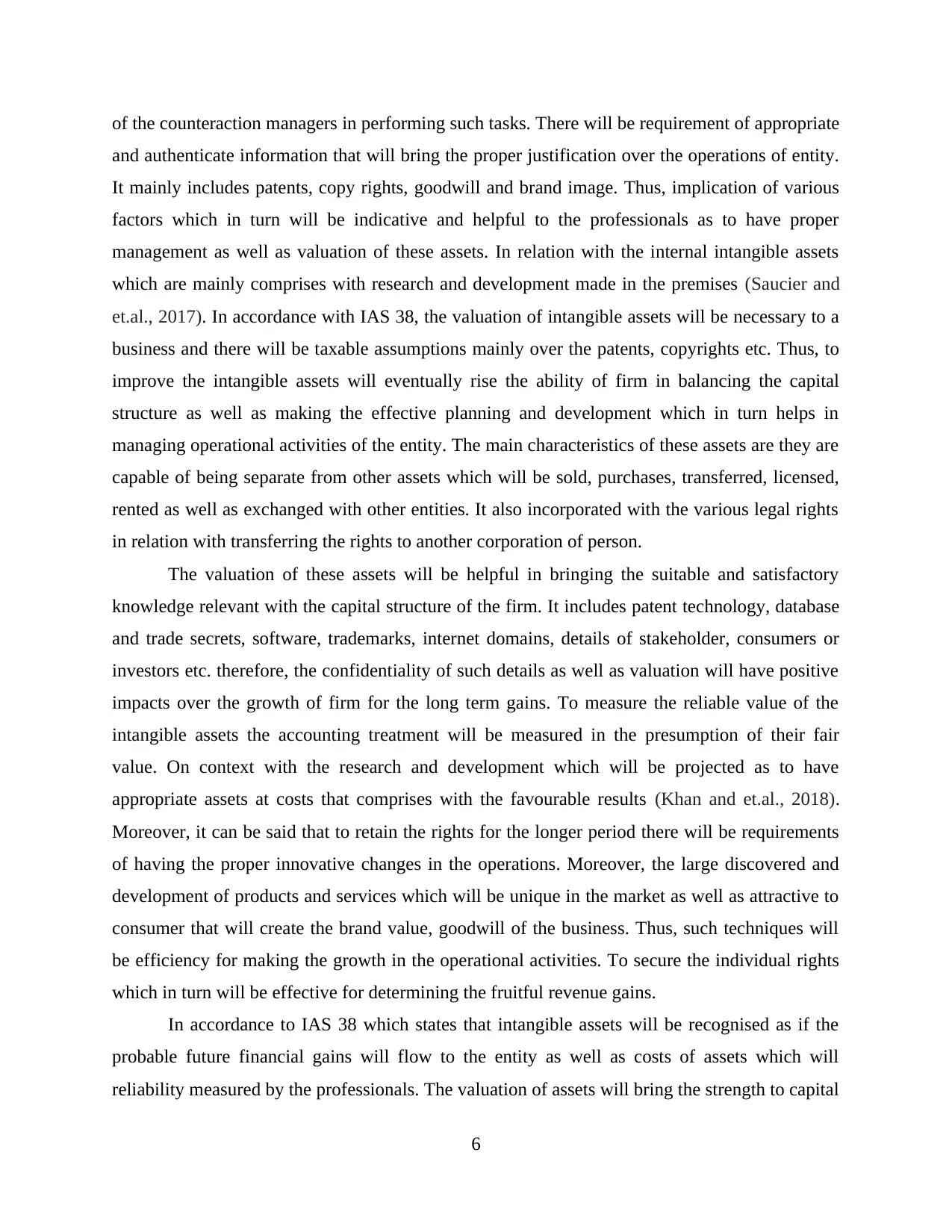
of the counteraction managers in performing such tasks. There will be requirement of appropriate
and authenticate information that will bring the proper justification over the operations of entity.
It mainly includes patents, copy rights, goodwill and brand image. Thus, implication of various
factors which in turn will be indicative and helpful to the professionals as to have proper
management as well as valuation of these assets. In relation with the internal intangible assets
which are mainly comprises with research and development made in the premises (Saucier and
et.al., 2017). In accordance with IAS 38, the valuation of intangible assets will be necessary to a
business and there will be taxable assumptions mainly over the patents, copyrights etc. Thus, to
improve the intangible assets will eventually rise the ability of firm in balancing the capital
structure as well as making the effective planning and development which in turn helps in
managing operational activities of the entity. The main characteristics of these assets are they are
capable of being separate from other assets which will be sold, purchases, transferred, licensed,
rented as well as exchanged with other entities. It also incorporated with the various legal rights
in relation with transferring the rights to another corporation of person.
The valuation of these assets will be helpful in bringing the suitable and satisfactory
knowledge relevant with the capital structure of the firm. It includes patent technology, database
and trade secrets, software, trademarks, internet domains, details of stakeholder, consumers or
investors etc. therefore, the confidentiality of such details as well as valuation will have positive
impacts over the growth of firm for the long term gains. To measure the reliable value of the
intangible assets the accounting treatment will be measured in the presumption of their fair
value. On context with the research and development which will be projected as to have
appropriate assets at costs that comprises with the favourable results (Khan and et.al., 2018).
Moreover, it can be said that to retain the rights for the longer period there will be requirements
of having the proper innovative changes in the operations. Moreover, the large discovered and
development of products and services which will be unique in the market as well as attractive to
consumer that will create the brand value, goodwill of the business. Thus, such techniques will
be efficiency for making the growth in the operational activities. To secure the individual rights
which in turn will be effective for determining the fruitful revenue gains.
In accordance to IAS 38 which states that intangible assets will be recognised as if the
probable future financial gains will flow to the entity as well as costs of assets which will
reliability measured by the professionals. The valuation of assets will bring the strength to capital
6
and authenticate information that will bring the proper justification over the operations of entity.
It mainly includes patents, copy rights, goodwill and brand image. Thus, implication of various
factors which in turn will be indicative and helpful to the professionals as to have proper
management as well as valuation of these assets. In relation with the internal intangible assets
which are mainly comprises with research and development made in the premises (Saucier and
et.al., 2017). In accordance with IAS 38, the valuation of intangible assets will be necessary to a
business and there will be taxable assumptions mainly over the patents, copyrights etc. Thus, to
improve the intangible assets will eventually rise the ability of firm in balancing the capital
structure as well as making the effective planning and development which in turn helps in
managing operational activities of the entity. The main characteristics of these assets are they are
capable of being separate from other assets which will be sold, purchases, transferred, licensed,
rented as well as exchanged with other entities. It also incorporated with the various legal rights
in relation with transferring the rights to another corporation of person.
The valuation of these assets will be helpful in bringing the suitable and satisfactory
knowledge relevant with the capital structure of the firm. It includes patent technology, database
and trade secrets, software, trademarks, internet domains, details of stakeholder, consumers or
investors etc. therefore, the confidentiality of such details as well as valuation will have positive
impacts over the growth of firm for the long term gains. To measure the reliable value of the
intangible assets the accounting treatment will be measured in the presumption of their fair
value. On context with the research and development which will be projected as to have
appropriate assets at costs that comprises with the favourable results (Khan and et.al., 2018).
Moreover, it can be said that to retain the rights for the longer period there will be requirements
of having the proper innovative changes in the operations. Moreover, the large discovered and
development of products and services which will be unique in the market as well as attractive to
consumer that will create the brand value, goodwill of the business. Thus, such techniques will
be efficiency for making the growth in the operational activities. To secure the individual rights
which in turn will be effective for determining the fruitful revenue gains.
In accordance to IAS 38 which states that intangible assets will be recognised as if the
probable future financial gains will flow to the entity as well as costs of assets which will
reliability measured by the professionals. The valuation of assets will bring the strength to capital
6
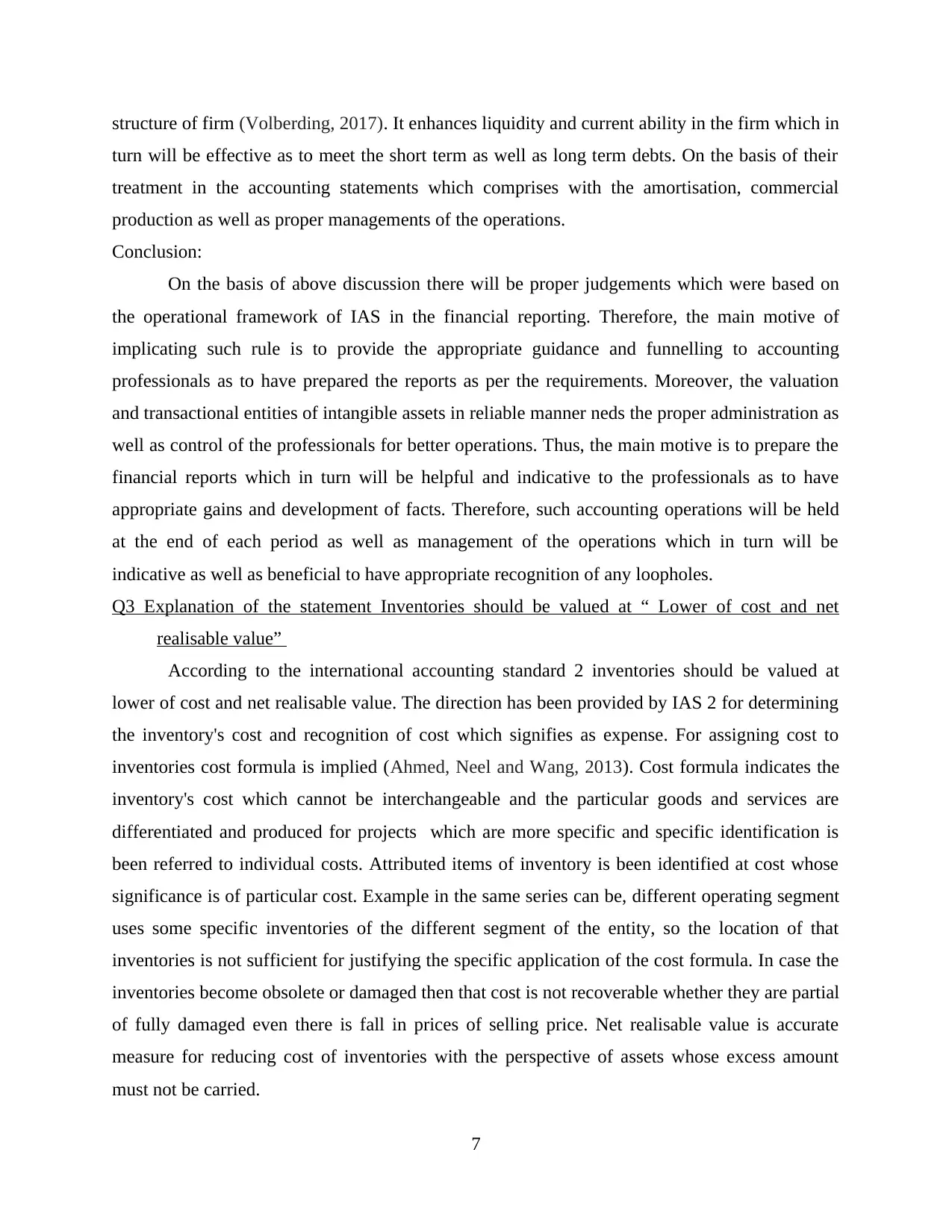
structure of firm (Volberding, 2017). It enhances liquidity and current ability in the firm which in
turn will be effective as to meet the short term as well as long term debts. On the basis of their
treatment in the accounting statements which comprises with the amortisation, commercial
production as well as proper managements of the operations.
Conclusion:
On the basis of above discussion there will be proper judgements which were based on
the operational framework of IAS in the financial reporting. Therefore, the main motive of
implicating such rule is to provide the appropriate guidance and funnelling to accounting
professionals as to have prepared the reports as per the requirements. Moreover, the valuation
and transactional entities of intangible assets in reliable manner neds the proper administration as
well as control of the professionals for better operations. Thus, the main motive is to prepare the
financial reports which in turn will be helpful and indicative to the professionals as to have
appropriate gains and development of facts. Therefore, such accounting operations will be held
at the end of each period as well as management of the operations which in turn will be
indicative as well as beneficial to have appropriate recognition of any loopholes.
Q3 Explanation of the statement Inventories should be valued at “ Lower of cost and net
realisable value”
According to the international accounting standard 2 inventories should be valued at
lower of cost and net realisable value. The direction has been provided by IAS 2 for determining
the inventory's cost and recognition of cost which signifies as expense. For assigning cost to
inventories cost formula is implied (Ahmed, Neel and Wang, 2013). Cost formula indicates the
inventory's cost which cannot be interchangeable and the particular goods and services are
differentiated and produced for projects which are more specific and specific identification is
been referred to individual costs. Attributed items of inventory is been identified at cost whose
significance is of particular cost. Example in the same series can be, different operating segment
uses some specific inventories of the different segment of the entity, so the location of that
inventories is not sufficient for justifying the specific application of the cost formula. In case the
inventories become obsolete or damaged then that cost is not recoverable whether they are partial
of fully damaged even there is fall in prices of selling price. Net realisable value is accurate
measure for reducing cost of inventories with the perspective of assets whose excess amount
must not be carried.
7
turn will be effective as to meet the short term as well as long term debts. On the basis of their
treatment in the accounting statements which comprises with the amortisation, commercial
production as well as proper managements of the operations.
Conclusion:
On the basis of above discussion there will be proper judgements which were based on
the operational framework of IAS in the financial reporting. Therefore, the main motive of
implicating such rule is to provide the appropriate guidance and funnelling to accounting
professionals as to have prepared the reports as per the requirements. Moreover, the valuation
and transactional entities of intangible assets in reliable manner neds the proper administration as
well as control of the professionals for better operations. Thus, the main motive is to prepare the
financial reports which in turn will be helpful and indicative to the professionals as to have
appropriate gains and development of facts. Therefore, such accounting operations will be held
at the end of each period as well as management of the operations which in turn will be
indicative as well as beneficial to have appropriate recognition of any loopholes.
Q3 Explanation of the statement Inventories should be valued at “ Lower of cost and net
realisable value”
According to the international accounting standard 2 inventories should be valued at
lower of cost and net realisable value. The direction has been provided by IAS 2 for determining
the inventory's cost and recognition of cost which signifies as expense. For assigning cost to
inventories cost formula is implied (Ahmed, Neel and Wang, 2013). Cost formula indicates the
inventory's cost which cannot be interchangeable and the particular goods and services are
differentiated and produced for projects which are more specific and specific identification is
been referred to individual costs. Attributed items of inventory is been identified at cost whose
significance is of particular cost. Example in the same series can be, different operating segment
uses some specific inventories of the different segment of the entity, so the location of that
inventories is not sufficient for justifying the specific application of the cost formula. In case the
inventories become obsolete or damaged then that cost is not recoverable whether they are partial
of fully damaged even there is fall in prices of selling price. Net realisable value is accurate
measure for reducing cost of inventories with the perspective of assets whose excess amount
must not be carried.
7
⊘ This is a preview!⊘
Do you want full access?
Subscribe today to unlock all pages.

Trusted by 1+ million students worldwide
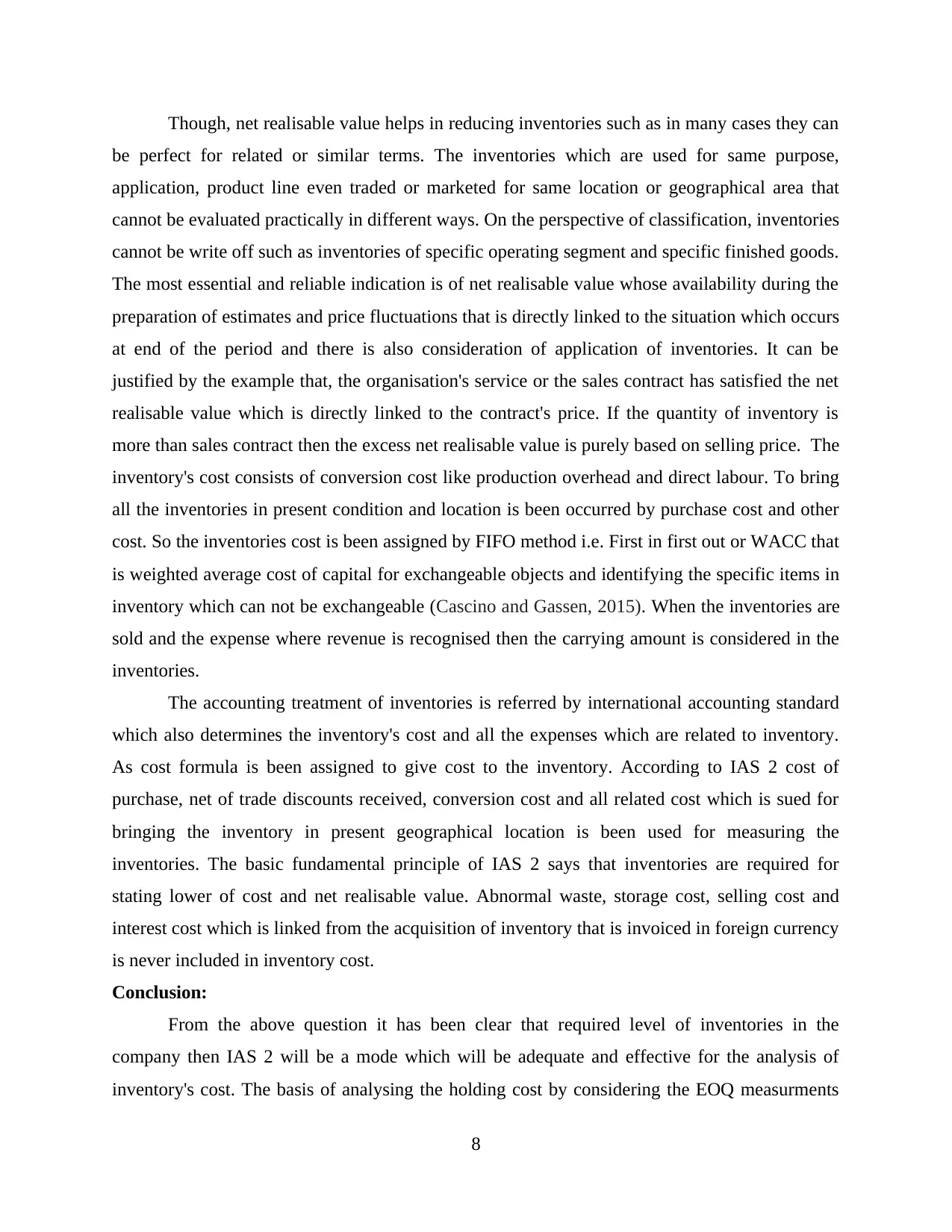
Though, net realisable value helps in reducing inventories such as in many cases they can
be perfect for related or similar terms. The inventories which are used for same purpose,
application, product line even traded or marketed for same location or geographical area that
cannot be evaluated practically in different ways. On the perspective of classification, inventories
cannot be write off such as inventories of specific operating segment and specific finished goods.
The most essential and reliable indication is of net realisable value whose availability during the
preparation of estimates and price fluctuations that is directly linked to the situation which occurs
at end of the period and there is also consideration of application of inventories. It can be
justified by the example that, the organisation's service or the sales contract has satisfied the net
realisable value which is directly linked to the contract's price. If the quantity of inventory is
more than sales contract then the excess net realisable value is purely based on selling price. The
inventory's cost consists of conversion cost like production overhead and direct labour. To bring
all the inventories in present condition and location is been occurred by purchase cost and other
cost. So the inventories cost is been assigned by FIFO method i.e. First in first out or WACC that
is weighted average cost of capital for exchangeable objects and identifying the specific items in
inventory which can not be exchangeable (Cascino and Gassen, 2015). When the inventories are
sold and the expense where revenue is recognised then the carrying amount is considered in the
inventories.
The accounting treatment of inventories is referred by international accounting standard
which also determines the inventory's cost and all the expenses which are related to inventory.
As cost formula is been assigned to give cost to the inventory. According to IAS 2 cost of
purchase, net of trade discounts received, conversion cost and all related cost which is sued for
bringing the inventory in present geographical location is been used for measuring the
inventories. The basic fundamental principle of IAS 2 says that inventories are required for
stating lower of cost and net realisable value. Abnormal waste, storage cost, selling cost and
interest cost which is linked from the acquisition of inventory that is invoiced in foreign currency
is never included in inventory cost.
Conclusion:
From the above question it has been clear that required level of inventories in the
company then IAS 2 will be a mode which will be adequate and effective for the analysis of
inventory's cost. The basis of analysing the holding cost by considering the EOQ measurments
8
be perfect for related or similar terms. The inventories which are used for same purpose,
application, product line even traded or marketed for same location or geographical area that
cannot be evaluated practically in different ways. On the perspective of classification, inventories
cannot be write off such as inventories of specific operating segment and specific finished goods.
The most essential and reliable indication is of net realisable value whose availability during the
preparation of estimates and price fluctuations that is directly linked to the situation which occurs
at end of the period and there is also consideration of application of inventories. It can be
justified by the example that, the organisation's service or the sales contract has satisfied the net
realisable value which is directly linked to the contract's price. If the quantity of inventory is
more than sales contract then the excess net realisable value is purely based on selling price. The
inventory's cost consists of conversion cost like production overhead and direct labour. To bring
all the inventories in present condition and location is been occurred by purchase cost and other
cost. So the inventories cost is been assigned by FIFO method i.e. First in first out or WACC that
is weighted average cost of capital for exchangeable objects and identifying the specific items in
inventory which can not be exchangeable (Cascino and Gassen, 2015). When the inventories are
sold and the expense where revenue is recognised then the carrying amount is considered in the
inventories.
The accounting treatment of inventories is referred by international accounting standard
which also determines the inventory's cost and all the expenses which are related to inventory.
As cost formula is been assigned to give cost to the inventory. According to IAS 2 cost of
purchase, net of trade discounts received, conversion cost and all related cost which is sued for
bringing the inventory in present geographical location is been used for measuring the
inventories. The basic fundamental principle of IAS 2 says that inventories are required for
stating lower of cost and net realisable value. Abnormal waste, storage cost, selling cost and
interest cost which is linked from the acquisition of inventory that is invoiced in foreign currency
is never included in inventory cost.
Conclusion:
From the above question it has been clear that required level of inventories in the
company then IAS 2 will be a mode which will be adequate and effective for the analysis of
inventory's cost. The basis of analysing the holding cost by considering the EOQ measurments
8
Paraphrase This Document
Need a fresh take? Get an instant paraphrase of this document with our AI Paraphraser
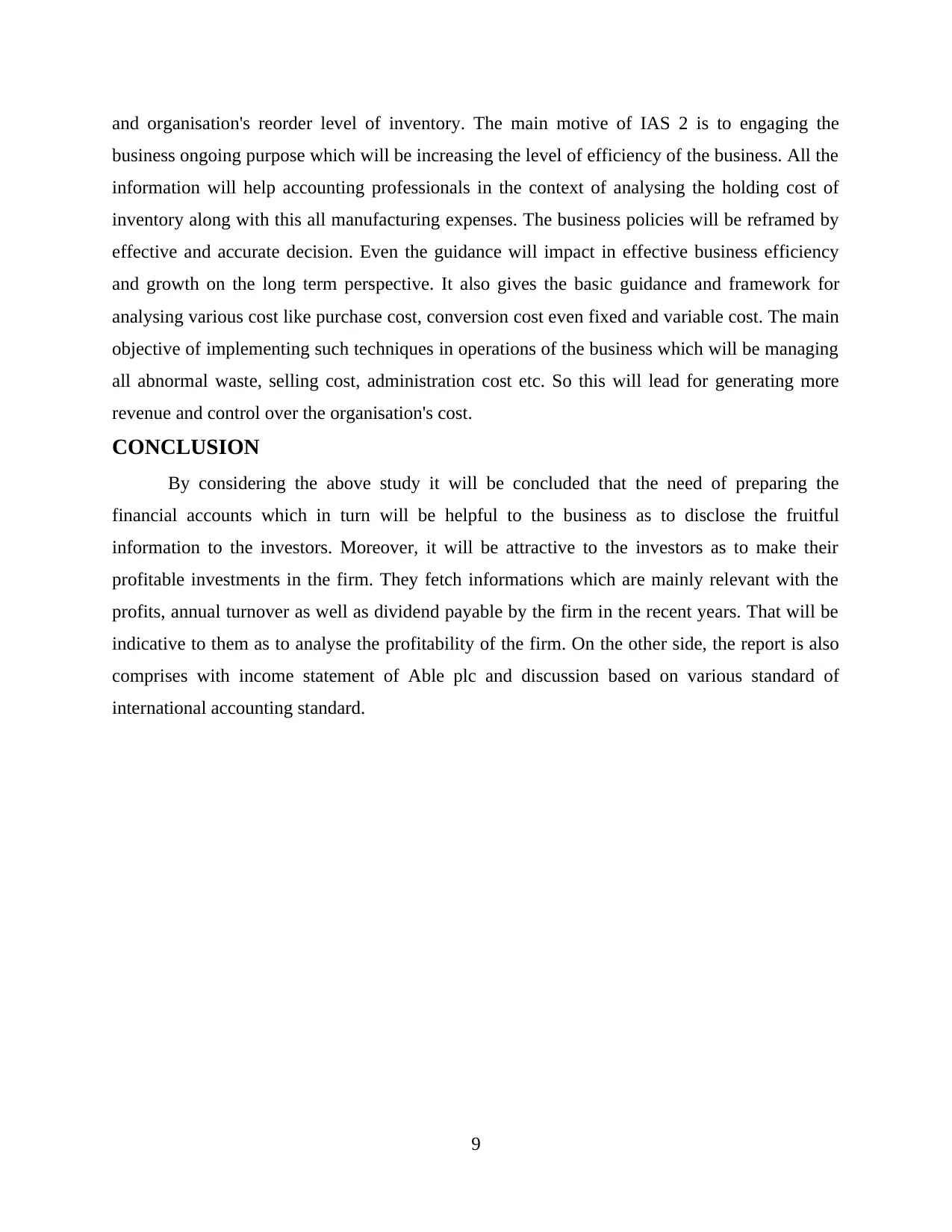
and organisation's reorder level of inventory. The main motive of IAS 2 is to engaging the
business ongoing purpose which will be increasing the level of efficiency of the business. All the
information will help accounting professionals in the context of analysing the holding cost of
inventory along with this all manufacturing expenses. The business policies will be reframed by
effective and accurate decision. Even the guidance will impact in effective business efficiency
and growth on the long term perspective. It also gives the basic guidance and framework for
analysing various cost like purchase cost, conversion cost even fixed and variable cost. The main
objective of implementing such techniques in operations of the business which will be managing
all abnormal waste, selling cost, administration cost etc. So this will lead for generating more
revenue and control over the organisation's cost.
CONCLUSION
By considering the above study it will be concluded that the need of preparing the
financial accounts which in turn will be helpful to the business as to disclose the fruitful
information to the investors. Moreover, it will be attractive to the investors as to make their
profitable investments in the firm. They fetch informations which are mainly relevant with the
profits, annual turnover as well as dividend payable by the firm in the recent years. That will be
indicative to them as to analyse the profitability of the firm. On the other side, the report is also
comprises with income statement of Able plc and discussion based on various standard of
international accounting standard.
9
business ongoing purpose which will be increasing the level of efficiency of the business. All the
information will help accounting professionals in the context of analysing the holding cost of
inventory along with this all manufacturing expenses. The business policies will be reframed by
effective and accurate decision. Even the guidance will impact in effective business efficiency
and growth on the long term perspective. It also gives the basic guidance and framework for
analysing various cost like purchase cost, conversion cost even fixed and variable cost. The main
objective of implementing such techniques in operations of the business which will be managing
all abnormal waste, selling cost, administration cost etc. So this will lead for generating more
revenue and control over the organisation's cost.
CONCLUSION
By considering the above study it will be concluded that the need of preparing the
financial accounts which in turn will be helpful to the business as to disclose the fruitful
information to the investors. Moreover, it will be attractive to the investors as to make their
profitable investments in the firm. They fetch informations which are mainly relevant with the
profits, annual turnover as well as dividend payable by the firm in the recent years. That will be
indicative to them as to analyse the profitability of the firm. On the other side, the report is also
comprises with income statement of Able plc and discussion based on various standard of
international accounting standard.
9
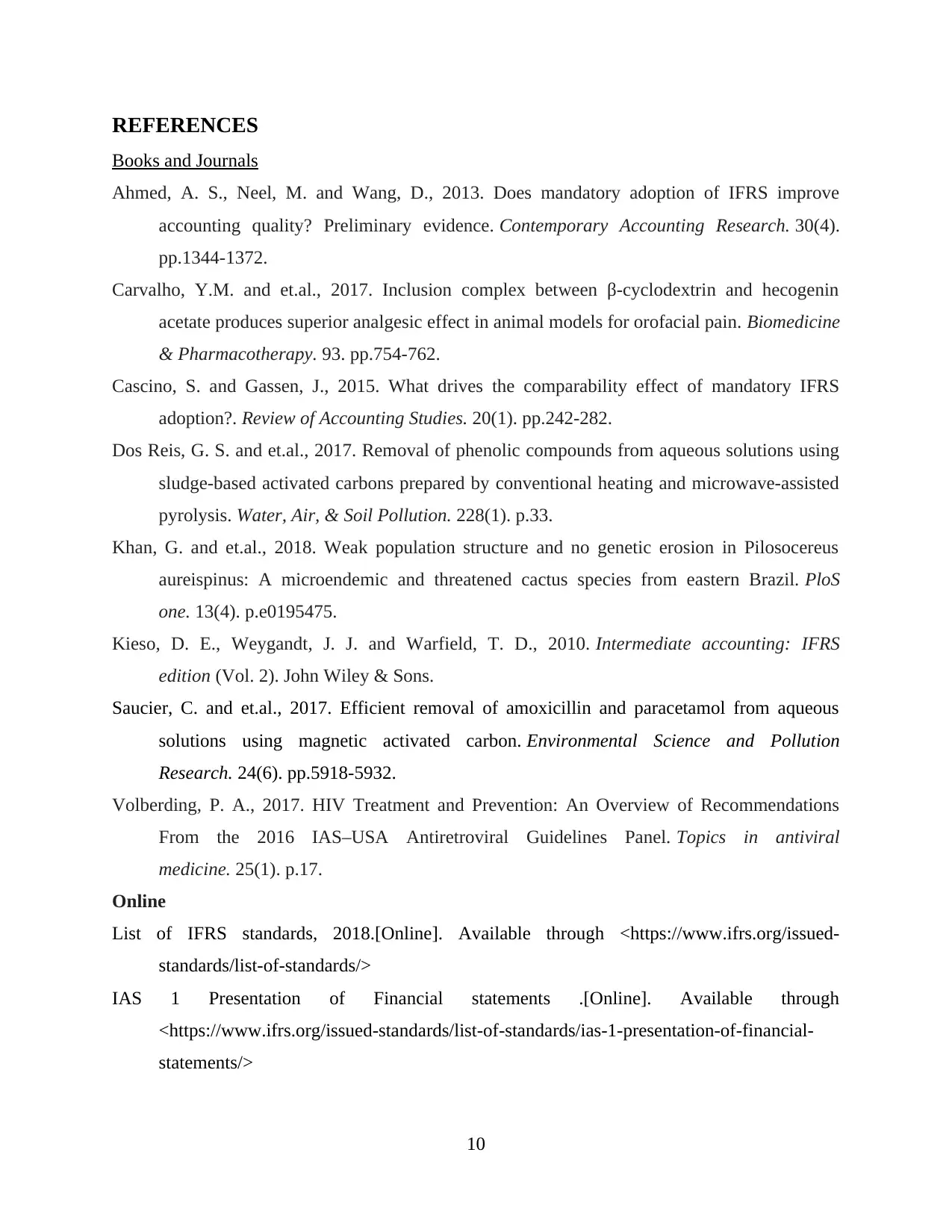
REFERENCES
Books and Journals
Ahmed, A. S., Neel, M. and Wang, D., 2013. Does mandatory adoption of IFRS improve
accounting quality? Preliminary evidence. Contemporary Accounting Research. 30(4).
pp.1344-1372.
Carvalho, Y.M. and et.al., 2017. Inclusion complex between β-cyclodextrin and hecogenin
acetate produces superior analgesic effect in animal models for orofacial pain. Biomedicine
& Pharmacotherapy. 93. pp.754-762.
Cascino, S. and Gassen, J., 2015. What drives the comparability effect of mandatory IFRS
adoption?. Review of Accounting Studies. 20(1). pp.242-282.
Dos Reis, G. S. and et.al., 2017. Removal of phenolic compounds from aqueous solutions using
sludge-based activated carbons prepared by conventional heating and microwave-assisted
pyrolysis. Water, Air, & Soil Pollution. 228(1). p.33.
Khan, G. and et.al., 2018. Weak population structure and no genetic erosion in Pilosocereus
aureispinus: A microendemic and threatened cactus species from eastern Brazil. PloS
one. 13(4). p.e0195475.
Kieso, D. E., Weygandt, J. J. and Warfield, T. D., 2010. Intermediate accounting: IFRS
edition (Vol. 2). John Wiley & Sons.
Saucier, C. and et.al., 2017. Efficient removal of amoxicillin and paracetamol from aqueous
solutions using magnetic activated carbon. Environmental Science and Pollution
Research. 24(6). pp.5918-5932.
Volberding, P. A., 2017. HIV Treatment and Prevention: An Overview of Recommendations
From the 2016 IAS–USA Antiretroviral Guidelines Panel. Topics in antiviral
medicine. 25(1). p.17.
Online
List of IFRS standards, 2018.[Online]. Available through <https://www.ifrs.org/issued-
standards/list-of-standards/>
IAS 1 Presentation of Financial statements .[Online]. Available through
<https://www.ifrs.org/issued-standards/list-of-standards/ias-1-presentation-of-financial-
statements/>
10
Books and Journals
Ahmed, A. S., Neel, M. and Wang, D., 2013. Does mandatory adoption of IFRS improve
accounting quality? Preliminary evidence. Contemporary Accounting Research. 30(4).
pp.1344-1372.
Carvalho, Y.M. and et.al., 2017. Inclusion complex between β-cyclodextrin and hecogenin
acetate produces superior analgesic effect in animal models for orofacial pain. Biomedicine
& Pharmacotherapy. 93. pp.754-762.
Cascino, S. and Gassen, J., 2015. What drives the comparability effect of mandatory IFRS
adoption?. Review of Accounting Studies. 20(1). pp.242-282.
Dos Reis, G. S. and et.al., 2017. Removal of phenolic compounds from aqueous solutions using
sludge-based activated carbons prepared by conventional heating and microwave-assisted
pyrolysis. Water, Air, & Soil Pollution. 228(1). p.33.
Khan, G. and et.al., 2018. Weak population structure and no genetic erosion in Pilosocereus
aureispinus: A microendemic and threatened cactus species from eastern Brazil. PloS
one. 13(4). p.e0195475.
Kieso, D. E., Weygandt, J. J. and Warfield, T. D., 2010. Intermediate accounting: IFRS
edition (Vol. 2). John Wiley & Sons.
Saucier, C. and et.al., 2017. Efficient removal of amoxicillin and paracetamol from aqueous
solutions using magnetic activated carbon. Environmental Science and Pollution
Research. 24(6). pp.5918-5932.
Volberding, P. A., 2017. HIV Treatment and Prevention: An Overview of Recommendations
From the 2016 IAS–USA Antiretroviral Guidelines Panel. Topics in antiviral
medicine. 25(1). p.17.
Online
List of IFRS standards, 2018.[Online]. Available through <https://www.ifrs.org/issued-
standards/list-of-standards/>
IAS 1 Presentation of Financial statements .[Online]. Available through
<https://www.ifrs.org/issued-standards/list-of-standards/ias-1-presentation-of-financial-
statements/>
10
⊘ This is a preview!⊘
Do you want full access?
Subscribe today to unlock all pages.

Trusted by 1+ million students worldwide
1 out of 13
Related Documents
Your All-in-One AI-Powered Toolkit for Academic Success.
+13062052269
info@desklib.com
Available 24*7 on WhatsApp / Email
![[object Object]](/_next/static/media/star-bottom.7253800d.svg)
Unlock your academic potential
Copyright © 2020–2025 A2Z Services. All Rights Reserved. Developed and managed by ZUCOL.





![Managerial Accounting Assignment Solution - [University] [Semester]](/_next/image/?url=https%3A%2F%2Fdesklib.com%2Fmedia%2Fimages%2Fnr%2Feb6ffb76356e457ab3cc2da237f03df4.jpg&w=256&q=75)